Removal of Hexavalent Chromium(VI) from Wastewater Using Chitosan-Coated Iron Oxide Nanocomposite Membranes
Abstract
:1. Introduction
2. Materials and Methods
2.1. General Methods
2.2. Preparation of the Composite Membrane (Chi@Fe2O3–PVDF)
2.3. Analytical Instruments and Characterization of the Composite Membrane (Chi@Fe2O3–PVDF)
2.4. Adsorbate Preparation
2.5. Adsorption Experiments
2.5.1. Adsorption Experiments Using Batch System
2.5.2. Adsorption Experiments Using Continuous-Flow System
2.5.3. Adsorption Isotherms
2.5.4. Adsorption Kinetics
3. Results and Discussion
3.1. Characterization of Nanocomposite Membrane
3.2. Effect of Solution pH
3.3. Adsorption of Cr(VI) Using Chi@Fe2O3–PVDF
3.3.1. Batch System
3.3.2. Continuous In-Flow System
3.4. Effect of Coexisting Ions on Removal Efficiency in Real Water Samples
4. Conclusions
Supplementary Materials
Author Contributions
Funding
Institutional Review Board Statement
Informed Consent Statement
Data Availability Statement
Conflicts of Interest
References
- Dinker, M.K.; Kulkarni, P.S. Recent advances in silica-based materials for the removal of hexavalent chromium: A Review. J. Chem. Eng. Data 2015, 60, 2521–2540. [Google Scholar] [CrossRef]
- Lui, W.E.; Yang, L.; Xu, S. Efficient removal of hexavalent chromium from water by an adsorption–reduction mechanism with sandwiched nanocomposites. RSC Adv. 2018, 8, 15087–15093. [Google Scholar] [CrossRef] [Green Version]
- Liu, Y.; Luo, C.; Cui, G.; Yan, S. Synthesis of manganese dioxide/iron oxide/graphene oxide magnetic nanocomposites for hexavalent chromium removal. RSC Adv. 2015, 5, 54156–54164. [Google Scholar] [CrossRef]
- Mahmoud, M.R.; Lazaridis, N.K. Simultaneous removal of Nickel(II) and Chromium(VI) from aqueous solutions and simulated wastewaters by foam separation. Sep. Sci. Technol. 2015, 50, 1421–1432. [Google Scholar] [CrossRef]
- Kim, C.; Kim, H. Study on chemical decontamination process based on permanganic acid-oxalic acid to remove oxide layer deposited in primary system of nuclear power plant. J. Nucl. Fuel Cycle Waste Technol. 2019, 17, 15–28. [Google Scholar] [CrossRef]
- Amdur, M.O.; Doull, J.; Klaassen, C.D. Casarett and Doull’s toxicology. J. Occup. Med. 1993, 35, 76. [Google Scholar]
- Fang, J.; Gu, Z.; Gang, D.; Liu, C.; Ilton, E.S.; Deng, B. Cr(VI) removal from aqueous solution by actovated carbon coated with quaternized poly(4-vinylpyridine). Environ. Sci. Technol. 2007, 41, 4748–4753. [Google Scholar] [CrossRef]
- Zhitkovich, A. Chromium in drinking water: Sources, metabolism, and cancer risks. Chem. Res. Toxicol. 2011, 24, 1617–1629. [Google Scholar] [CrossRef]
- Golder, A.K.; Chanda, A.K.; Samanta, A.N.; Ray, S. Removal of hexavalent chromium by electrochemical reduction–precipitation: Investigation of process performance and reaction stoichiometry. Separation and purification technology. Sep. Purif. Technol. 2011, 76, 345–350. [Google Scholar] [CrossRef]
- Kongsricharoern, N.; Polpracert, C. Chromium removal by a bipolar electro-chemical precipitation process. Water Sci. Technol. 1996, 34, 109–116. [Google Scholar] [CrossRef]
- Zhang, X.; Ren, B.; Wu, X.; Yan, X.; Sun, Y.; Gao, H.; Qu, F. Efficient removal of Chromium(VI) using a novel waste biomass chestnut shell-based carbon electrode by electrosorption. ACS Omega 2021, 6, 25389–25396. [Google Scholar] [CrossRef] [PubMed]
- Çimen, A. Removal of chromium from wastewater by reverse osmosis. Russ. J. Phys. Chem. 2015, 89, 1238–1243. [Google Scholar] [CrossRef]
- Yoon, J.; Amy, G.; Chung, J.; Sohn, J.; Yoon, Y. Removal of toxic ions (chromate, arsenate, and perchlorate) using reverse osmosis, nanofiltration, and ultrafiltration membranes. Chemosphere 2009, 77, 228–235. [Google Scholar] [CrossRef] [PubMed]
- Li, G.; Qin, F.; Wang, R.; Xiao, S.; Sun, H.; Chen, R. BiOX (X=Cl, Br, I) nanostructures: Mannitol-mediated microwave synthesis, visible light photocatalytic performance, and Cr(VI) removal capacity. J. Colloid Interface Sci. 2013, 409, 43–51. [Google Scholar] [CrossRef] [PubMed]
- Rengaraj, S.; Joo, C.K.; Kim, Y.; Yi, J. Kinetics of removal of chromium from water and electronic process wastewater by ion exchange resins: 1200H, 1500H and IRN97H. J. Hazard. Mater. 2003, 102, 257–275. [Google Scholar] [CrossRef]
- Alothman, Z.A.; Allam, M.M.; Naushad, M. Heavy toxic metal ion exchange kinetics: Validation of ion exchange process on composite cation exchanger nylon 6,6 Zr(IV) phosphate. J. Ind. Eng. Chem. 2013, 19, 956–960. [Google Scholar] [CrossRef]
- Gupta, V.K.; Agarwal, S.; Saleh, T.A. Chromium removal by combining the magnetic properties of iron oxide with adsorption properties of carbon nanotubes. Water Res. 2011, 45, 2207–2212. [Google Scholar] [CrossRef]
- Singaraj, S.G.; Mahanty, B.; Balachandran, D.; Padmaprabha, A. Adsorption and desorption of chromium with humic acid coated iron oxide nanoparticles. Environ. Sci. Pollut. Res. Int. 2019, 26, 30044–30054. [Google Scholar] [CrossRef]
- Luo, C.; Tian, Z.; Yang, B.; Zang, L.; Yan, S. Manganese dioxide/iron oxide/acid oxidized multi-walled carbon nanotube magnetic nanocomposite for enhanced hexavalent chromium removal. Chem. Eng. J. 2013, 234, 256–265. [Google Scholar] [CrossRef]
- Gallo-Cordova, A.; Morales, M.D.; Mazarío, E. Effect of the surface charge on the adsorption capacity of Chromium(VI) of iron oxide magnetic nanoparticles prepared by microwave-assisted synthesis. Water 2019, 11, 2372. [Google Scholar] [CrossRef] [Green Version]
- Egodawatte, S.; Datt, A.; Burns, E.A.; Larsen, S.C. Chemical insight into the adsorption of chromium(III) on iron oxide/mesoporous silica nanocomposites. Langmuir 2015, 31, 7553–7562. [Google Scholar] [CrossRef] [PubMed]
- Altun, T.; Ecevit, H. Cr(VI) removal using Fe2O3-chitosan-cherry kernel shell pyrolytic charcoal composite beads. Environ. Eng. Res. 2020, 25, 426–438. [Google Scholar] [CrossRef] [Green Version]
- Marques Neto, J.O.; Bellato, C.R.; Silva, D.C. Iron oxide/carbon nanotubes/chitosan magnetic composite film for chromium species removal. Chemosphere 2019, 218, 391–401. [Google Scholar] [CrossRef] [PubMed]
- Subedi, N.; Lähde, A.; Abu-Danso, E.; Iqbal, J.; Bhatnagar, A. A comparative study of magnetic chitosan (Chi@Fe3O4) and graphene oxide modified magnetic chitosan (Chi@Fe3O4GO) nanocomposites for efficient removal of Cr(VI) from water. Int. J. Biol, Macromol. 2019, 137, 948–959. [Google Scholar] [CrossRef]
- Zhang, B.; Hu, R.; Sun, D.; Wu, T.; Li, Y. Fabrication of chitosan/magnetite-graphene oxide composites as a novel bioadsorbent for adsorption and detoxification of Cr(VI) from aqueous solution. Sci. Rep. 2018, 8, 15397. [Google Scholar] [CrossRef] [Green Version]
- Muthumareeswaran, M.R.; Alhoshan, M.; Agarwal, G.P. Ultrafiltration membrane for effective removal of chromium ions from potable water. Sci. Rep. 2017, 7, 41423. [Google Scholar] [CrossRef] [Green Version]
- Geise, G.M.; Lee, H.-S.; Miller, D.J.; Freeman, B.D.; McGrath, J.E.; Paul, D.R. Water purification by membranes: The role of polymer science. J. Polym. Sci. B Polym. Phys. 2010, 48, 1685–1718. [Google Scholar] [CrossRef]
- Ertas, Y.; Uyar, T. Fabrication of cellulose acetate/polybenzoxazine cross-linked electrospun nanofibrous membrane for water treatment. Carbohydr. Polym. 2017, 177, 378–387. [Google Scholar] [CrossRef]
- Shim, H.E.; Yang, J.E.; Jeong, S.W.; Lee, C.H.; Song, L.; Mushtaq, S.; Choi, D.S.; Choi, Y.J.; Jeon, J. Silver nanomaterial-immobilized desalination systems for efficient removal of radioactive iodine species in water. Nanomaterials 2018, 8, 660. [Google Scholar] [CrossRef] [Green Version]
- Aizawa, K.; Gantt, E. Rapid method for assay of quantitative binding of soluble proteins and photosynthetic membrane proteins on poly(vinylidene difluoride) membranes. Anal. Chim. Acta 1998, 365, 109–113. [Google Scholar] [CrossRef]
- Hoefs, J. Stable Isotope Geochemistry; Springer: Berlin/Heidelberg, Germany; Gottingen, Germany, 2009. [Google Scholar]
- Sankararamakrishnan, N.; Dixit, A.; Iyengar, L.; Sanghi, R. Removal of hexavalent chromium using a novel cross linked xanthated chitosan. Bioresour. Technol. 2006, 97, 2377–2382. [Google Scholar] [CrossRef] [PubMed]
- Park, J.E.; Shim, H.E.; Mushtaq, S.; Choi, Y.J.; Jeon, J. A Functionalized nanocomposite adsorbent for the sequential removal of radioactive iodine and cobalt ions in aqueous media. Korean J. Chem. Eng. 2020, 37, 2209–2215. [Google Scholar] [CrossRef]
- Mushtaq, S.; Yun, S.-J.; Yang, J.E.; Jeong, S.-W.; Shim, H.E.; Choi, M.H.; Park, S.H.; Choi, Y.J.; Jeon, J. Efficient and selective removal of radioactive iodine anions using engineered nanocomposite membranes. Environ. Sci. Nano 2017, 4, 2157–2163. [Google Scholar] [CrossRef]
- Lace, A.; Ryan, D.; Bowkett, M.; Cleary, J. Chromium monitoring in water by colorimetry using optimised 1,5-diphenylcarbazide method. Int. J. Environ. Res. Public Health 2019, 16, 1803. [Google Scholar] [CrossRef] [Green Version]
- Samrot, A.V.; Sahithya, C.S.; Selvarani, A.J.; Pachiyappan, S.; Kumar, S.S. Surface-engineered super-paramagnetic iron oxide nanoparticles for chromium removal. Int. J. Nanomed. 2019, 14, 8105–8119. [Google Scholar] [CrossRef] [Green Version]
- Bhaumik, M.; Agarwal, S.; Gupta, V.K.; Maity, A. Enhanced removal of Cr(VI) from aqueous solutions using polypyrrole wrapped oxidized MWCNTs nanocomposites adsorbent. J. Colloid Interface Sci. 2016, 470, 257–267. [Google Scholar] [CrossRef]
- Shalaby, T.I.; Fikrt, N.M.; Mohamed, M.M.; El Kady, M.F. Preparation and characterization of iron oxide nanoparticles coated with chitosan for removal of Cd(II) and Cr(VI) from aqueous solution. Water Sci. Technol. 2014, 70, 1004–1010. [Google Scholar] [CrossRef]
- Almasri, D.A.; Saleh, N.B.; Atieh, M.A.; McKay, G.; Ahzi, S. Adsorption of phosphate on iron oxide doped halloysite nanotubes. Sci. Rep. 2019, 9, 3232. [Google Scholar] [CrossRef]
- Shahid, M.K.; Kim, Y.; Choi, Y.-G. Magnetite synthesis using iron oxide waste and its application for phosphate adsorption with column and batch reactors. Chem. Eng. Res. Des. 2019, 148, 169–179. [Google Scholar] [CrossRef]

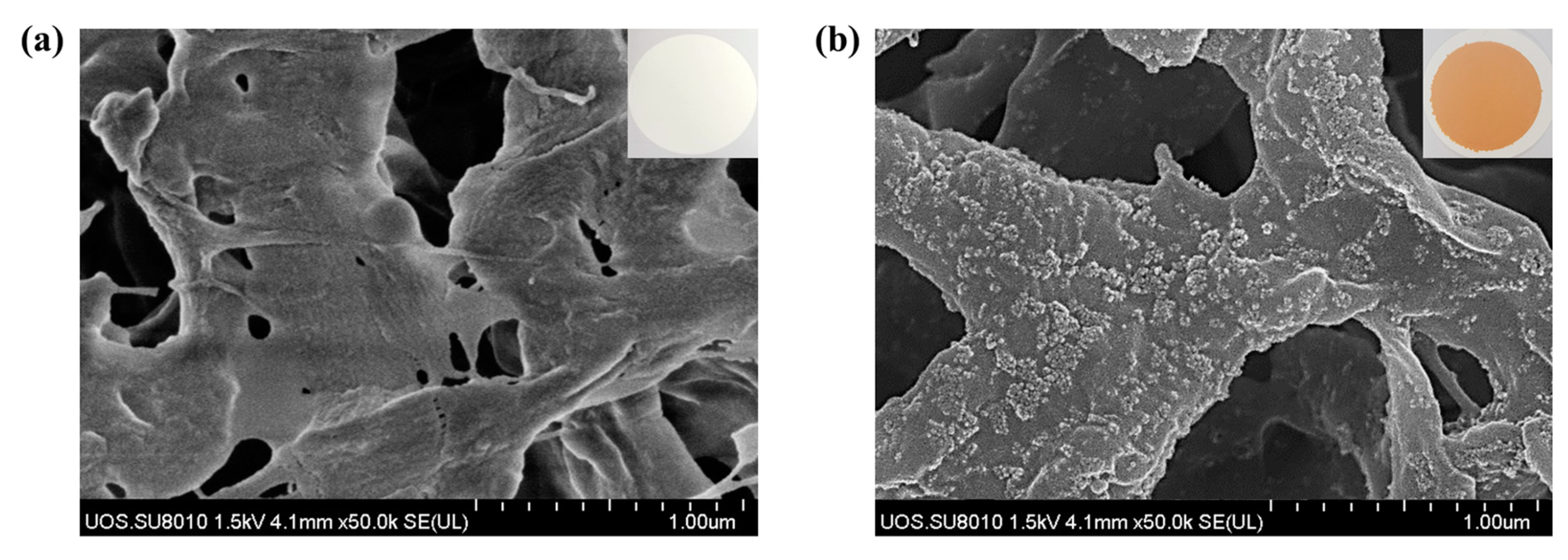


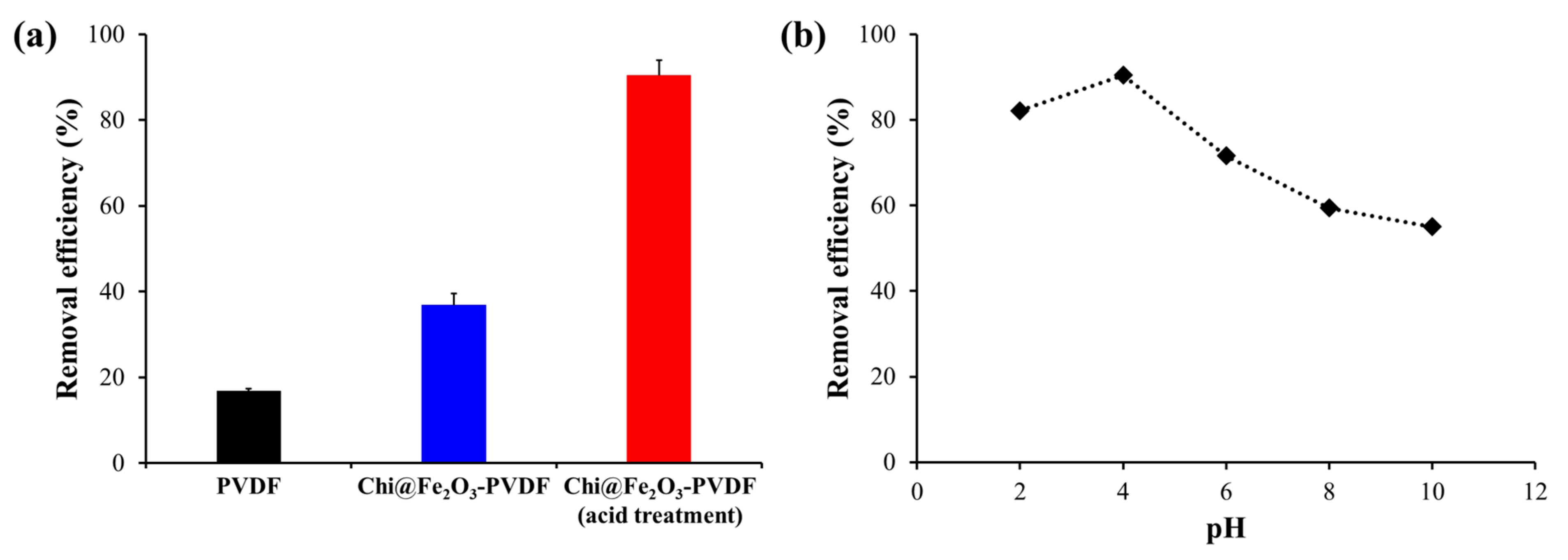
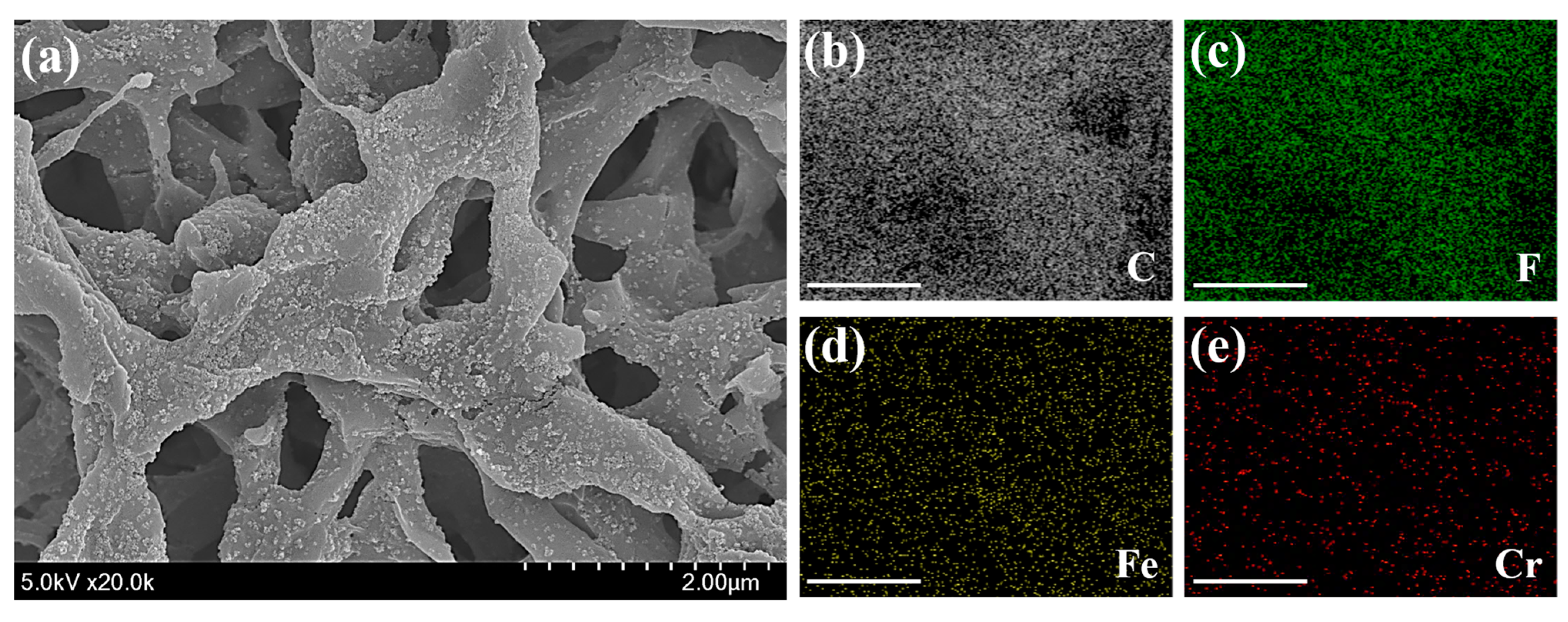
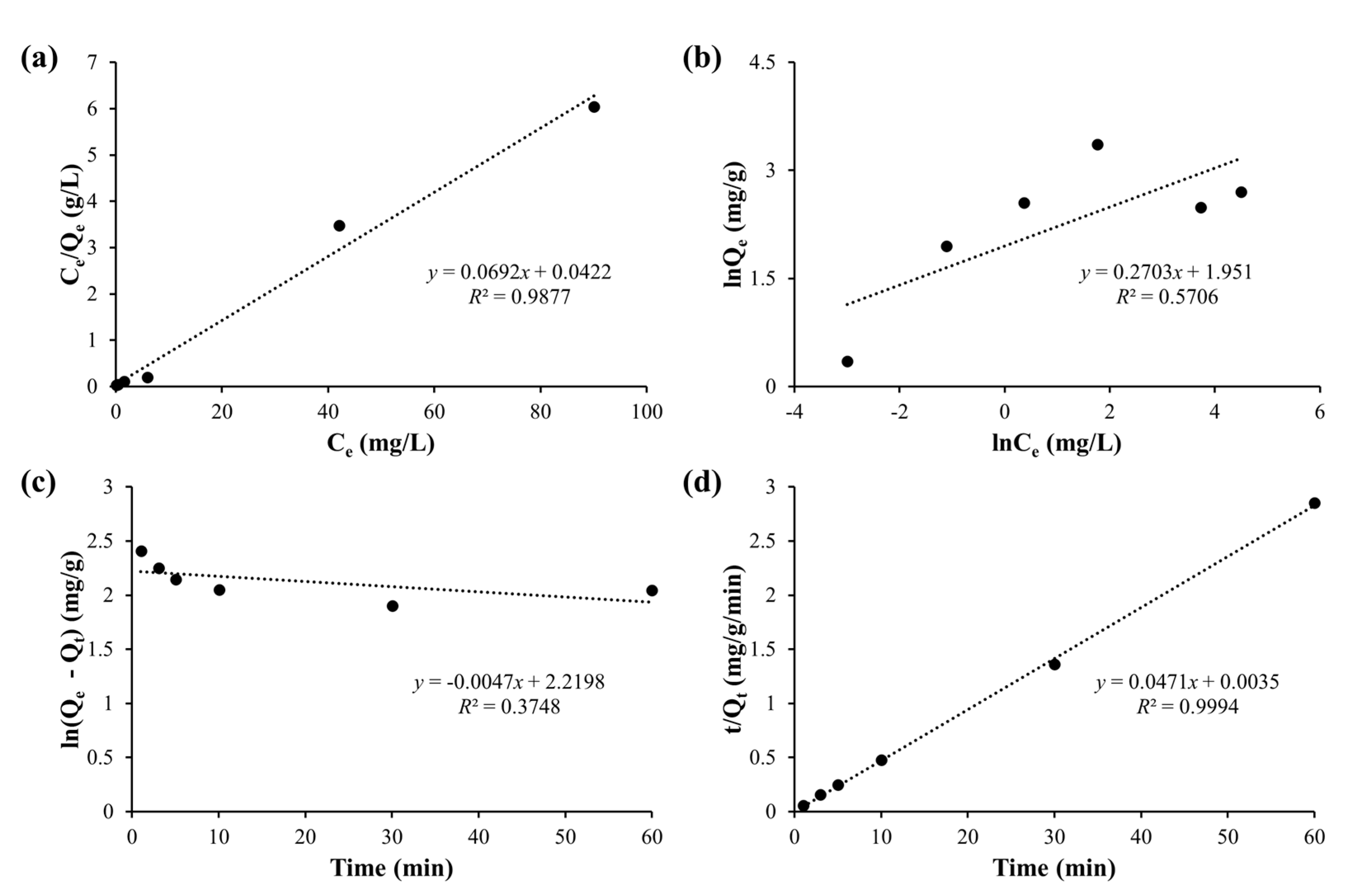
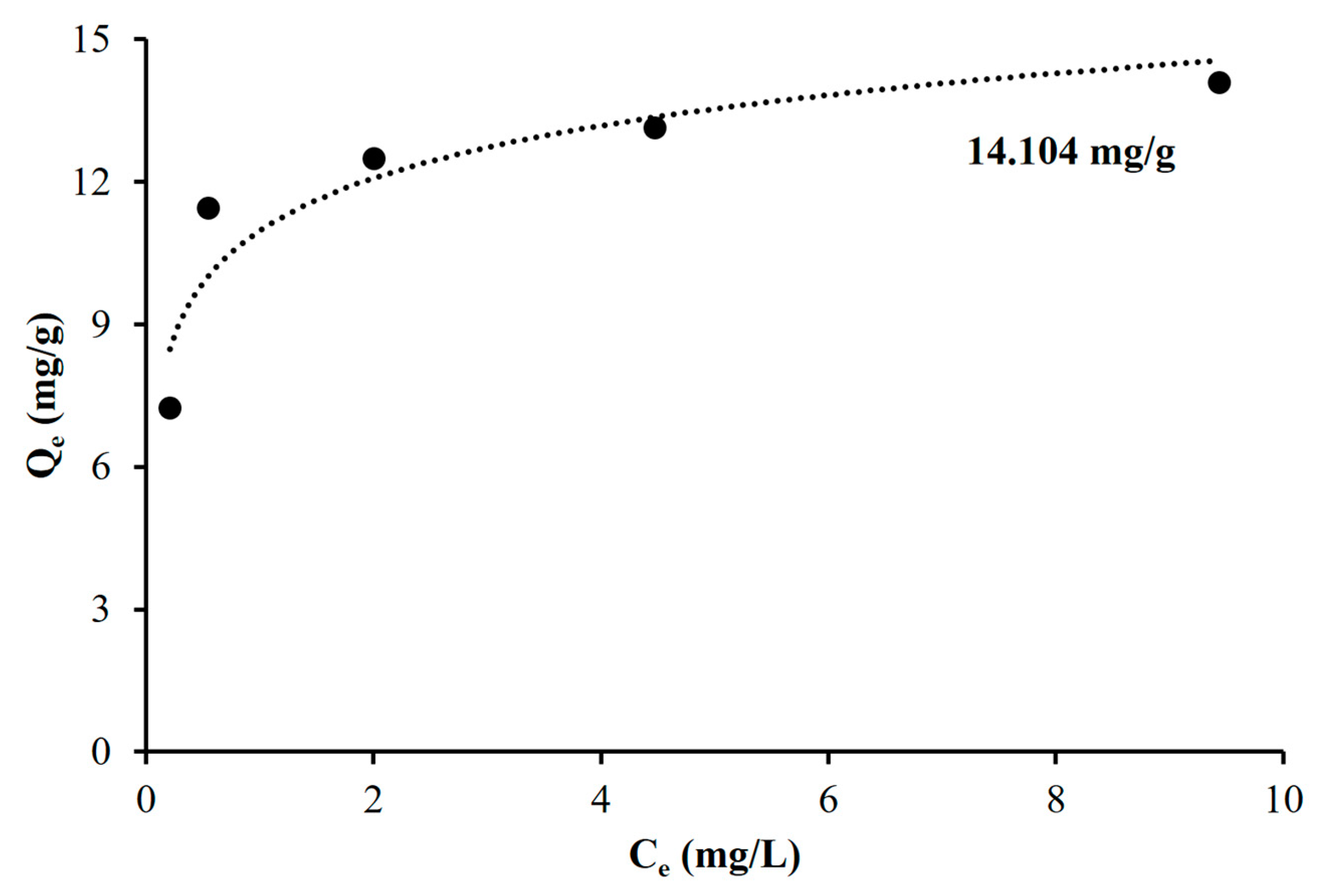

| Solvent | Chi@Fe2O3–PVDF | |
|---|---|---|
| ppm (mg/L) | Wt% | |
| Deionized water | N.D. | - |
| Cr(VI) 25 ppm (pH 4) | N.D. | - |
| Cr(VI) 25 ppm (pH 7) | 0.131 | 0.033% |
| Cr(VI) 25 ppm (pH 10) | 0.182 | 0.046% |
| 0.1 M HCl | 1.469 | 0.371% |
| 0.1 M NaOH | N.D. | - |
| 0.1 M NaCl | N.D. | - |
| System | Langmuir Constants | Freundlich Constants | |||||
|---|---|---|---|---|---|---|---|
| KL (L mg−1) | Qmax (mg g−1) | R2 | KF (mg g−1) (L mg−1)1/n | n | R2 | ||
| Batch | 1.640 | 14.451 | 0.998 | 7.036 | 3.670 | 0.571 | |
| Continuous-Flow | 18.658 | 14.104 | 0.995 | 11.454 | 6.337 | 0.527 | |
| System | Experimental value | Pseudo-first order | Pseudo-second order | ||||
| Qe,exp (mg g−1) | k1 (min−1) | Qe,cal (mg g−1) | R2 | k2 (g mg−1 min−1) | Qe,cal (mg g−1) | R2 | |
| Batch | 28.737 | 0.011 | 9.206 | 0.3748 | 0.634 | 21.231 | 0.9994 |
Publisher’s Note: MDPI stays neutral with regard to jurisdictional claims in published maps and institutional affiliations. |
© 2022 by the authors. Licensee MDPI, Basel, Switzerland. This article is an open access article distributed under the terms and conditions of the Creative Commons Attribution (CC BY) license (https://creativecommons.org/licenses/by/4.0/).
Share and Cite
Park, J.E.; Shin, J.-H.; Oh, W.; Choi, S.-J.; Kim, J.; Kim, C.; Jeon, J. Removal of Hexavalent Chromium(VI) from Wastewater Using Chitosan-Coated Iron Oxide Nanocomposite Membranes. Toxics 2022, 10, 98. https://doi.org/10.3390/toxics10020098
Park JE, Shin J-H, Oh W, Choi S-J, Kim J, Kim C, Jeon J. Removal of Hexavalent Chromium(VI) from Wastewater Using Chitosan-Coated Iron Oxide Nanocomposite Membranes. Toxics. 2022; 10(2):98. https://doi.org/10.3390/toxics10020098
Chicago/Turabian StylePark, Jung Eun, Jun-Ho Shin, Wonzin Oh, Sang-June Choi, Jeongju Kim, Chorong Kim, and Jongho Jeon. 2022. "Removal of Hexavalent Chromium(VI) from Wastewater Using Chitosan-Coated Iron Oxide Nanocomposite Membranes" Toxics 10, no. 2: 98. https://doi.org/10.3390/toxics10020098
APA StylePark, J. E., Shin, J. -H., Oh, W., Choi, S. -J., Kim, J., Kim, C., & Jeon, J. (2022). Removal of Hexavalent Chromium(VI) from Wastewater Using Chitosan-Coated Iron Oxide Nanocomposite Membranes. Toxics, 10(2), 98. https://doi.org/10.3390/toxics10020098






